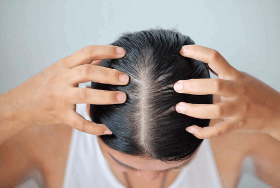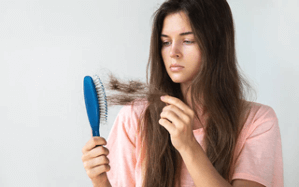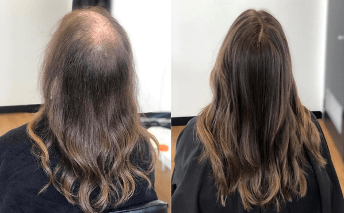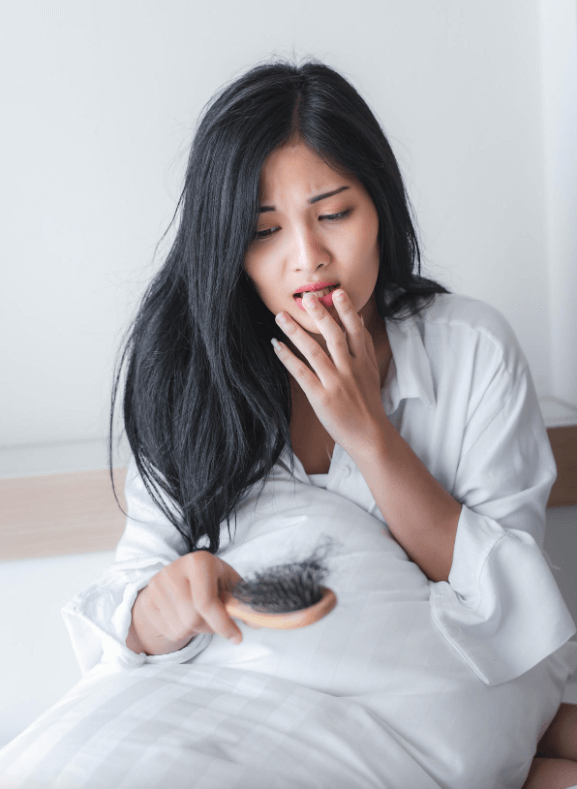Introduction

While it is sometimes normal to lose a few strands of hair,
around 50-100
, daily, it becomes a problem when the number of strands lost daily runs into thousands, and the frequency becomes incessant. Hair loss can take a huge toll on some women’s mental health and self-esteem; hence, many women have resorted to different means to stop the premature falling of their hair.
Hair loss is a major health issue affecting many women worldwide. We will look at what hair loss entails, its cause, prevention, and ways you can grow and maintain healthy hair. So, if you notice your hair has been thinning or a troubling number of hair strands on your comb every time you brush your hair, or there is probably a hair monster in your washroom you apply after every shower, read on to find out all you should know about hair loss.
What is Hair Loss?

As the name sounds, hair loss means losing your hair. This is a prevalent issue, especially among older women. According to a
study
, 40% of all women experience hair loss to some extent by the time they reach age 40. As said earlier, losing a few strands of your hair is quite normal. In fact, hair loss should ordinarily not be a problem, as the body works so that lost hair is replaced with new hair. However, this doesn’t always happen in this condition. Hair loss occurs gradually, and they are not replaced.
The rate of hair loss can vary significantly depending on the cause. While some happen gradually over a long period, some happen very abruptly. The loss can also be long-lasting or temporary, depending on the cause of the hair loss. There are many reasons for hair loss, and they pose different levels of danger to the integrity of your hair. However, before we get to that, below are the common hair loss symptoms.
Symptoms of Hair Loss
There are different ways to check if you have hair loss, the most common of which is the pull test used by dermatologists everywhere. It involves grabbing a handful of hair from different parts of your scalp and lightly tugging on it. If six or more strands of hair fall out, you may be suffering from hair loss.
The Pull Test may not be absolute, as the main clue of alopecia is losing more hair than usual, which may be pretty challenging to identify. Hence, the following symptoms will help you make a more informed decision.
-
Widening Part
. Gently part your hair; if you notice your part is getting wider than usual, that can be a sign of thinning hair. -
Receding Hairline.
A receding hairline may also indicate an early sign of hair loss, especially if it happens abruptly.
-
Loose Hair.
Ordinarily, after use, your comb should have a few strands of hair on it; however, if it starts collecting more than usual strands of hair, that may be a sign of hair loss.
-
Bald Patches.
Bald patches are the most typical signs of alopecia. Usually, they start small in size and grow over time. They are easier to manage when the sizes are small.
-
Clogged Drains.
Check your shower drains or sinks for strands of hair. They may fall off while washing their hair.
-
Pain or Itching.
This is common in people with an underlying skin condition. They experience itching and pain on their scalps.
Causes of Hair Loss

The causes of hair loss vary significantly, and they determine the severity and longevity of the hair loss. Let’s consider three of the most common causes of hair loss.
1.
Stress
One of the most common causes of hair loss in women is stress. Stress of different kinds, including emotional, physical, and mental, can
disrupt the body’s natural hair growth process and result in falling
. It also can cause the body to enter “survival mode,” in which the body rations fuel and energy to support its most vital functions.
Every hair follicle goes through a growth phase (anagen phase) and a resting phase (telogen). When the body is under stress, the hair follicles skip the growth phase and prematurely get into the rest phase. This affects the integrity of the hair and results in falling. This is called
telogen effluvium
.
In stress-induced hair loss, the strands of hair begin to fall off after about three months of exposure to stress, and it can last for up to six months. The excellent news is that stress-induced hair loss is not long-lasting. Once you are no longer going through stress, regrowth starts happening. Usually, it takes about 12 to 18 months for complete hair regrowth, depending on the extent of the hair loss.

Different factors can trigger stress-induced hair loss. Some of these factors include;
- Illness, like COVID-19, Polycystic Ovary Syndrome (PCOS), etc.
- Surgery
- Giving birth
- Medications such as, anticonvulsants, anticoagulants, anticonvulsants, oral retinoids, beta-blockers, thyroid medications, etc.
- Bereavement
- Relationship breakup
- A change in medications
- Job loss
- Extreme weight loss
2.
Dieting
Certain essential nutrients are
needed for the mature and healthy growth of the hair follicles,
such as minerals such as iron, zinc, and vitamin D. If these crucial nutrients are absent, the integrity of the hair follicles is affected and can result in fallout. Your body also perceives crash dieting, which could result in rapid weight loss, as a stressful event that can trigger stress-induced hair loss.
Although hair loss resulting from nutritional deficiency is temporary, if it continues over a long period, it can long-lastingly damage your hair follicles and limit your ability to regrow. For example,
Iron deficiency
is the most common nutritional deficiency worldwide and can lead to hair fall. According to a
study
, women with hair loss had significantly lower serum ferritin levels.
A
scientific review
also associated hair loss in women with low levels of Zinc.
3.
Genetics
The leading cause of hair loss in both men and women is genetics. Hereditary hair loss is responsible for about hair loss in
50% of women
. Hereditary hair loss, also called Androgenic alopecia, can be inherited from both parents and in women, hereditary hair loss starts very early. It usually starts from around age 40, and according to a
survey
, at age 50, 40% of women have major hair loss.
In most women, hair thinning progresses slowly over the years, but without treatment, it might affect the whole scalp, making it long-lasting.
Treatment Options for Hair Loss
There are several treatment options for hair loss, but the most effective choice will depend on the cause of the hair loss. We will group the treatments options into two categories, they are;
- Nonsurgical Treatment Options, and
- Surgical Treatments.
Let’s consider them briefly.
1.
Nonsurgical Treatment
The most common treatment options are non-surgical. They typically involve the use of medications, both topical and oral, to stimulate hair growth.
-
Oral Medications.
Many over-the-counter drugs are available to either slow down or stop hair loss. These drugs work by stimulating hair growth hormone or impeding the action of the cause of hair loss. -
Topical Medications.
Products such as shampoos, hair growth serums, and hair conditioners containing biotin, keratin, etc., are all manufactured to improve the health and integrity of the hair and scalp. -
Low-level laser therapy (LLLT):
This non-invasive technique uses a laser to stimulate hair growth by improving blood flow to the hair follicles. -
Platelet-rich plasma (PRP) therapy:
This method
involves injecting platelet-rich plasma
, derived from the patient’s blood, into the scalp to stimulate hair growth.
However, consult your physician before opting for any treatment options.
2. Surgical Treatments
Hair transplant surgery is usually the most preferred treatment for long-lasting hair loss. It involves moving small plugs of skin, each with a few hairs, to bald parts of your scalp. This procedure may need to be done more than once because some hair loss can be progressive. It is essential you consult with a physician for proper diagnosis and treatment options.
Prevention of Hair Loss

Luckily, some things can be done to prevent hair loss or impede the progression. Beloe are a few;
- Avoid touching your hair. As basic as this is, not adhering to it can result in significant hair loss. Hence, try not to pull, twist, or rub your hair as much as possible.
- Pat hair dry. Get a towel, and gently pat your hair dry. Don’t rumple, twist, or rub harshly with the towel. Be careful.
- Go for a nutrient-rich, balanced diet. This is essential. Try to incorporate plenty of iron and protein into snacks and meals. Eat as many fruits and vegetables as you like; they are good sources of essential nutrients for healthy hair growth.
Moreso, reduce and, if possible, cut out solid fats, alcohol, salts, and sugar. Go for water or healthy drinks.
❖ Keep hairstyles loose. Finally, keep loose hairstyles. Don’t put too much pressure on your hair. If you are the type that likes buns, ponytails, or braids, once in a while, keep your hair free and loosened.
Conclusion
Hair loss is one of the common health challenges facing several women worldwide. The severity varies with age and causes. While there are proven ways to treat hair loss, the most effective way is to prevent it. Some of the preventive measures have been highlighted. However, if you notice bald patches, hair shedding, thinning, or any other hair loss symptoms, ensure you see a dermatologist immediately.
Finally, although there are medications and procedures, steps like eating healthy, managing stress, and using dermatologically certified hair products are the best ways to ensure the integrity and health of your hair and hair follicles.
References
- Shannon, F., Christa, S., Lewei, D., & Carolyn, G. (2015). Demographics of women with female pattern hair loss and the effectiveness of spironolactone therapy. Journal of the American Academy of Dermatology, 73(4), 705.
https://doi.org/10.1016/j.jaad.2015.06.063
- Pratt, C. H., Messenger, A. G., Christiano, A. M., & Sundberg, J. P. (2017). Alopecia areata. Nature reviews. Disease primers, 3, 17011.
https://doi.org/10.1038/nrdp.2017.11
- J. Peters, E. M., Müller, Y., Snaga, W., Fliege, H., Reißhauer, A., Schmidt-Rose, T., Max, H., Schweiger, D., Rose, M., & Kruse, J. (2017). Hair and stress: A pilot study of hair and cytokine balance alteration in healthy young women under major exam stress. PLoS ONE, 12(4).
https://doi.org/10.1371/journal.pone.0175904
- Asghar, F., Shamim, N., Farooque, U., Sheikh, H., & Aqeel, R. (2020). Telogen Effluvium: A Review of the Literature. Cureus, 12(5).
https://doi.org/10.7759/cureus.8320
- Almohanna, H. M., Ahmed, A. A., Tsatalis, J. P., & Tosti, A. (2019). The Role of Vitamins and Minerals in Hair Loss: A Review. Dermatology and therapy, 9(1), 51–70.
https://doi.org/10.1007/s13555-018-0278-6
- Guo, E. L., & Katta, R. (2017). Diet and hair loss: Effects of nutrient deficiency and supplement use. Dermatology Practical & Conceptual, 7(1), 1-10.
https://doi.org/10.5826/dpc.0701a01
- Rasheed, H., Mahgoub, D., Hegazy, R., El-Komy, M., Abdel Hay, R., Hamid, M. A., & Hamdy, E. (2013). Serum ferritin and vitamin d in female hair loss: do they play a role?. Skin pharmacology and physiology, 26(2), 101–107.
https://doi.org/10.1159/000346698
- Dhaher, S. A., Yacoub, A. A., & Jacob, A. A. (2018). Estimation of Zinc and Iron Levels in the Serum and Hair of Women with Androgenetic Alopecia: Case–control Study. Indian Journal of Dermatology, 63(5), 369-374.
https://doi.org/10.4103/ijd.IJD_624_16
- Ho CH, Sood T, Zito PM. Androgenetic Alopecia. [Updated 2022 Oct 16]. In: StatPearls [Internet]. Treasure Island (FL): StatPearls Publishing; 2023 Jan-. Available from:
https://www.ncbi.nlm.nih.gov/books/NBK430924/
- Avci, P., Gupta, A., Sadasivam, M., Vecchio, D., Pam, Z., Pam, N., & Hamblin, M. R. (2013). Low-level laser (light) therapy (LLLT) in skin: Stimulating, healing, restoring. Seminars in cutaneous medicine and surgery, 32(1), 41.
https://www.ncbi.nlm.nih.gov/pmc/articles/PMC4126803/
- Gupta, S., Paliczak, A., & Delgado, D. (2021). Evidence-based indications of platelet-rich plasma therapy. Expert review of hematology, 14(1), 97–108.
https://doi.org/10.1080/17474086.2021.1860002
-
American Academy of Dermatology Association.
(n.d.). Do you have hair loss or hair shedding?

 By myulikeadmin
By myulikeadmin



